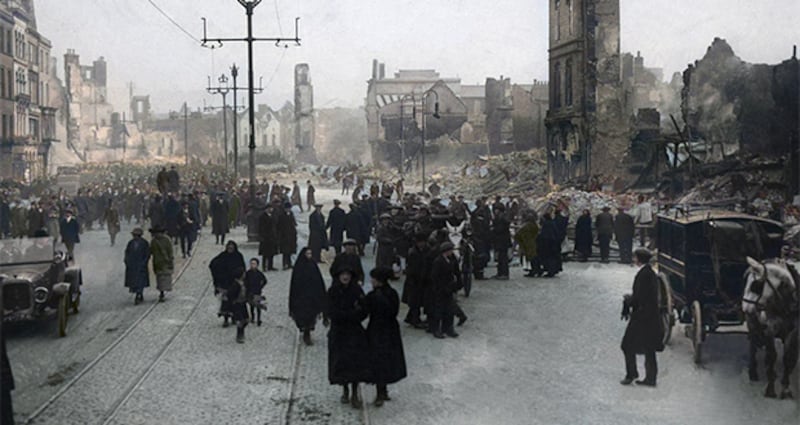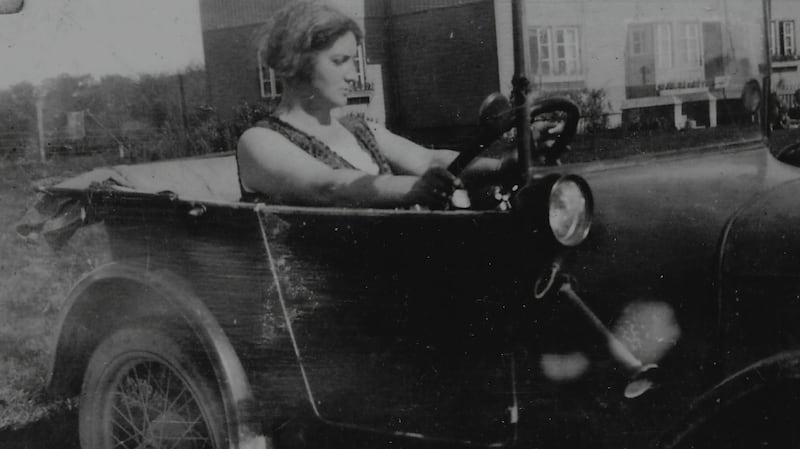The word combatants have been used in recent times to describe the contribution of Cumann na mBan. However, it must be remembered that when using the term and that while members of the organisation adopted a military uniform and their emblem was a weapon with the initials of the organisation intertwined, it was not an armed force. In the early years, the focus of the organisation had been on fundraising for the Defence of Ireland Fund to arm the Volunteers; some members had also acquired weapons. In the early years, in branches such as Limerick, there had been rifle practice.
By 1920, during what became known as the ‘Year of Terror’, training in firearms, where it existed, consisted of the cleaning and unloading of weapons. Cal McCarthy, in his book Cumann na mBan and the Irish Revolution, suggested “there was little point in training their members in a skill that would be of no use to them”.
A decision taken by the executive of Cumann na mBan in 1918 was significant for its members’ participation in what became known as the War of Independence (and had consequences in the awarding of military pensions). In a bid to build a cohesive fighting force, it was agreed that branch captains would henceforth take orders from Volunteer commanders.

While they may not have used weapons, women were responsible for transporting weapons on their person – their long coats and skirts facilitated their concealment. For those women who carried handbags, they also proved useful in collecting guns following surprise attacks. Not all of these ‘bag ladies’ were sworn members of Cumann na mBan, but part of a network of trusted supporters that included shopkeepers, other business owners and private individuals who provided supplies and shelter because they were sympathetic to the cause.
Reports from the Royal Irish Constabulary at the outset of the conflict did not view the role of Cumann na mBan as significant in many areas. That was to change over the period 1917-1921, especially in Munster. Some branches continued to be a public organisation to march and train, attend funerals in uniform, visit prisoners or congregate outside barracks and prisons where executions were taking place and collect and distribute monies for prisoners' dependants.
There were women who did administration for Dáil Éireann, which was establishing an alternative parliament. It must be remembered that those at the core of this oath-bound organisation would see the fact they never came to any official notice or had their role documented as successfully carrying out their duties. The police were hampered during raids – searching of women was not done by men, but by the end of 1920 the number of women searchers had increased in all parts of the country and arrests increased.
‘Safe houses’
Senior members of Cumann na mBan organisation such Mrs Winnie Gordon (nee Cassidy, later Mrs Stack) and Mrs Margaret Buckley (nee Goulding) were the widows of former members of the Royal Irish Constabulary, which gave them a cover for their 'safe houses' from neighbours and the police. At the same time, there was a boycott of families of serving members of the RIC conducted by Cumann na mBan during this period.
Other families, such as the Dalys from Limerick, were subjected to vicious attacks by the military both at their homes and workplace, the family bakery. Their experience was documented and used for propaganda purposes – they were very aware of making a record, leaving their accounts in various places including their solicitor's office, as raids often involved destroying premises by fire. First-hand experiences were important when the American Commission visited Ireland in 1920, seeking evidence for their report on conditions in Ireland.
There were several women who found it difficult being answerable to the male leadership of the Volunteers and worked independently. Linda Kearns, back in her native Sligo during this period, was not a member of Cumann na mBan when she was arrested and imprisoned for transporting arms.
Seeking out of trustworthy women for what was described as “dangerous work” was key to Michael Collins’ spy network – his preference was for women who were not members of Cumann na mBan, those he selected who were members, he asked to leave. Máire Kennedy (later Mrs O’Byrne) recalled him telling her “get out of Cumann na mBan and do some work”.
One of those who suffered reputational damage amongst her peers was one of his most trusted workers. Sorcha MacMahon (née Rogers) was also asked by Collins to leave the organisation to work exclusively for him. She had been presented with a magnificent silver inkwell, designed by Egan’s of Cork, with the emblems of Cumann na mBan as her wedding gift in 1917.
When she left Cumann na mBan on Collins’ instructions, she was cut off from all her former friends in the movement (and describes isolation in her home as she waited for instructions). Their anger that she played no part in the fight after 1917 is recorded in Kitty O’Doherty’s witness statement. It has only been with the release of pension records, now supplemented by private papers, that her role can be fully documented for the first time.

Lily Mernin was one of Collins' most effective operatives in Dublin Castle, known as Little Gentleman, or simply G. In early histories of this period, it is assumed G was a man – the male cover she used for espionage also concealed her from the public record.
Lily Mernin's own account from the Military Bureau allowed her to take credit for her actions. Anna McGuire's archive contains a letter from Tom Barry commiserating with her on her difficulty in obtaining a full pension, acknowledging the dangerous and secret work she had undertaken, when she worked as an intelligence officer in Bandon.
As Anna Mulqueen, she was set up first in Jones' Tobacconist, as that was frequented by British officers, and collaborated with her friend May Twomey, who worked in the post office. She became, in her own words, "friendly" with Maj Percival, and he organised a bicycle permit for her. Later, the IRA set her up in her own business, called Buckley & Co, as a cover for her activities. She was asked to join Cumann na mBan by Tom Barry to "conceal her cover".
In the early 1990s, I met one of the surviving Cumann na mBan members who had participated in the War of Independence. Mrs Draper, then Ita O’Gorman, befriended an Auxiliary to pass information to her boyfriend in the IRA. Remarkably, she was never suspected and even more remarkable, perhaps, is that she kept a copy of a photograph of this uniformed officer on his motorbike as evidence of her activities.
Intimidations
At several decades remove, I did not ask her if she feared having her hair cut and other intimidations experienced by women like Mary McGeehin, as outlined in this newspaper several times in July 1920. I listened with an incredulity and scepticism borne from a lack of specific knowledge of that time and I failed to ask the right questions of one of the last surviving women, who had been active in intelligence-gathering during this period. We were only beginning to extract women’s roles at all levels, and this was a very closed secret history.
At the same time as I met Ita Draper, I was introduced to Lily and Cissy Thewlis, Cumann na mBan members, the nieces of Agnes Mallin, née Hickey, the widow of Michael Mallin. They lived at the base of Knockmaroon Hill, Chapelizod, and spent the hour interviewing me – I left with an empty notebook but unknown to me, I'd past the trust test. A message was sent to me some months later that I was invited to tea, but to my deep regret I never returned, blindsided by the fact that their silence was a lack of knowledge, that I now know was their training. I include this story, because it may yield the whereabouts of the suitcase that documented their activities, which was to be shown to me on the next visit, which sadly never took place.
Constance Markievicz’s president’s address to the Cumann na mBan Convention in 1921 refers directly to the actions of Cumann na mBan members in the final months of 1920.
“How proud I am of the girls who stood in the gap of danger during the time of stress and war last winter. There was a generous chorus of praise from all parts of Ireland for the girls of Cumann na mBan on the way they have worked through the winter. Their courage, their capacity, and above all their discretion, were praised to me. These girls did daring and brave things that nobody ever heard of from anyone. The capacity too and the training as well as discretion and also the courage of those who were under fire, all deserve great praise. When the history of Ireland is written, the name of Cumann na mBan will be a name that will go down to your children, and your children’s children, and as an organisation will stand as a memorial to the Irish people as a great organisation of the past.”
The Civil War changed everything; the silence descended. The story of Cumann na mBan during the campaign for independence is still being pieced together, but as with so much of the past, much of the information is lost forever.









